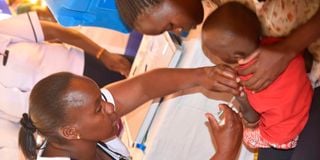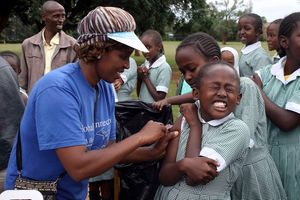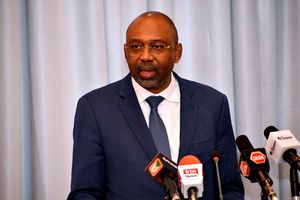Why Vihiga led nationally in childhood vaccination uptake rate

A nurse administers malaria vaccine to a child in Vihiga County on March 7, 2023.
What you need to know:
- Vihiga County emerged top countrywide for recording a 96 per cent immunisation rate.
- This means that nine in 10 children in Vihiga are fully immunised against basic antigens , which is above the country’s national average that stands at 80 per cent, according to the 2022 Kenya Demographic and Health Survey released early this year.
From community health workers to village elders and chiefs, they moved from one village to another at every door step. They were on a mission to find zero-dosed children and so they went all out to check on the immunisation records of children below the age of five. The community health volunteers were each allocated areas of coverage and follow-up. This new force came to being courtesy of a significant decrease in the number of fully vaccinated children in 2021. The number of fully immunised children was just 53 per cent.
Charity Akoyi, a nurse at Luanda Town Dispensary, was worried about this drop. In the second half of 2021, the percentage of children in the facility’s catchment area who received the first dose of the diphtheria, tetanus and pertussis (DTP) vaccine but did not complete the series of three doses increased from two per cent to 20 percent. The number of those receiving a second dose of other vaccines dropped from 11 per cent to three per cent coverage.
“These really bothered me and I wanted to understand the reason behind it,” she said.
Previously, mothers in the region overlooked immunisation and community leaders were not involved in immunisation outreach activities.
But with the help of Momentum Routine Immunisation Transformation and Equity project, healthcare workers formed a working team to address the challenges. The project supports health system strengthening to improve immunisation and maternal and child health outcomes
The initial stage was to develop a new community health strategy on how they were going to reach out to the communities and involve more community health volunteers (CHVs) in the work. The CHVs were trained together with the chiefs and elders to identify, map out and visit the households.
Under the Expanded Programme for Immunization (EPI), the healthcare workers were also trained to identify priority communities, address barriers, and develop work plans with solutions for more children to be vaccinated.
With the identification of the underserved communities coupled with several vaccination outreaches, the immunisation uptake in Luanda Town greatly improved. The rate of children who did not complete the three-dose DTP vaccine series decreased from 20 to four per cent, and the rate of children who received their second dose of the pneumococcal (PCV) vaccine increased from three to 16 per cent.
This intervention was scaled up in the rest of the sub-counties and it bore fruit, with Vihiga County emerging top countrywide for recording a 96 per cent immunisation rate.
This means that nine in 10 children in Vihiga are fully immunised against basic antigens , which is above the country’s national average that stands at 80 per cent, according to the 2022 Kenya Demographic and Health Survey released early this year.
Vihiga County’s Head of Immunisation at the Health Department Edith Anjere also linked the success to the achievement of a recommendation by the World Health Organization (WHO) that health facilities be constructed within a five-kilometre radius from the catchment population to facilitate access to healthcare.
She said the populous county has 98 health facilities that provide immunisation services across the county, with each given a target it should attain in a given period of time. She also lauded the political support from Governor Wilber Ottichilo.
She noted that sensitisation efforts put in place by the county health team in partnership with the local government has seen a marked rise in the number of patients visiting the local health facilities and therefore the number of children taking up immunisation services.
Some of the sensitisation campaign activities put in place include reminder messages sent out to the public by the local administration regarding the immunisation outreach dates to increase attendance.
Also, T-shirts bearing informative messages on immunisation were printed and are worn by the working team members to help in spreading important health information.
“Every year we do target setting, identify our target population and then engage our 98 health facilities where immunisation is provided. We have also held talk shows on local radio stations,to talk to the people and inform them about the importance of immunisation,” Edith added.
“A periodic review assessment is undertaken to ascertain whether we are achieving the set target and subject this to the quarterly review meetings.”
CHVs in the county are following up on the progress of all children undergoing immunisation until they complete the recommended schedule. Public barazas have also been key in reaching out to parents and caregivers of children aged below five years. “We involved the governor as a champion for primary healthcare due to his unwavering support for community health volunteers,” said Edith.
Healthcare providers, too, have undergone capacity building on the advances in immunisation to boost their expertise in this crucial area of child development. “When patients visit our facilities for treatment, we also talk to them about vaccination regardless of the age so that they can become our ambassadors when they get back to their homes,” she said.
The Ottichilo Care Programme has also played a key role. It was unveiled in 2018 by the governor, where every expectant mother who visits a health facilities for antenatal or postnatal care gets a stipend of Sh2, 000 as well as a personal care package during delivery.
This has increased hospital attendance and boosted the immunisation coverage.
The governor has also visited mothers enrolled under the Ottichilo care. Each of these mothers is linked to a community health volunteer for close monitoring and tracking.
“Ottichilo Care has helped much since it is set up such that one only benefits from it upon visiting the hospital, it has ensured that all children get immunised as mothers’ postnatal care services are directly linked to the child welfare clinic services where immunisation services are provided,” she said.
The programmed mobile phones issued to community health volunteers relay the reminder messages to people on the immunisation services. The messages are in English and Kiswahili languages. Some of the messages programmed into the phones include: “Je, unajua mtoto wako anafaa apate chanjo tarehe ......” and “Je, unajua unafaa ujifungulie hosipitalini penye kuna wataalamu”.
Edith, however, acknowledged that it is not easy to attain 100 per cent coverage. Some of the challenges include accounting for death and migration for some children who are still within the age when immunisation is done. “A few may be unresponsive to our sensitisation efforts, abandoning the process before completion. We can only strive to ensure we achieve 100 per cent coverage with the support of various partners such as UNICEF and PATH to help us in advocacy,” she said. Last month, in a speech read on her behalf by the acting Director of Health Dr Patrick Amoth during the launch of malaria vaccination in Vihiga County, Health Cabinet Secretary Susan Nakhumicha congratulated the devolved unit for achieving the highest routine immunisation coverage rate nationally.
“This, I believe, has been supported by a strong community health programme and I take this opportunity to urge the county to continue investing in primary health care and sustain this achievement,” she said.
The CS said the last Kenya Demographic Health Survey revealed that although close to 100 per cent of children begin immunisation as infants, more than 20 per cent are not completing the immunisation schedule.
She observed that the coverage of vaccines provided beyond the first year of life is lower in all counties, with the malaria vaccine given at 24 months being at only 36 per cent. She said the uptake of the second dose of measles stands at 58 per cent.
“We must therefore focus on ensuring that children receive all their due antigens and complete the schedule as recommended. We have all vaccines available, including the rotavirus vaccine,” she said.
“Children who have missed vaccination for one reason or the other should visit the nearest health facility for assessment and completion of schedule. At the Ministry of Health, we are keen to strengthen the defaulter tracing mechanisms to identify these children and vaccinate them,” she explained.






